What Is the School Counselor’s Role in PBIS/RTI in the School Counseling Program?
School Counselors need a comprehensive plan and a systematic process for understanding their role and responsibilities within our school community. School counselors and the school counseling program are key in this process because of their focus on personal, social, emotional, behavioral, academic, and career skills needed for success. School Counselors need to understand how to prioritize their time so they can reach the student-centered standards that only they can offer all students while being a member of the PBIS/RTI support team.
AOCC PBIS/RTI Presentation [PDF] 1MB
What Is the School Counselor’s Role in PBIS/RTI in the School Counseling Program?
AOCC 2018 Conference Hyatt Regency Columbus (Downtown) November 8, 2018 Session 11:15 – 12:15
Contact information for additional questions:
Tommie Radd, PhD, LPC, NSCC, NBCC,CRC: Consultant
Phone: 614-607-1373; email: [email protected]; web site: www.allsucceed.com
We can create true democratic classrooms that insist ALL students be accountable and responsible. School environments need to be examples of democracy in action. – Tommie R. Radd, PhD
What Is the School Counselor’s Role in PBIS/RTI in the School Counseling Program?
Agenda
- Introduction
- Definition – Positive Behavior Interventions and Support and Response to Intervention
- An Overview of Guidance System Components
- System Components
- Life Labs – The Heart of the Real Classroom
- The School Counseling Program School House
- Integration with PBIS/RTI Pyramid
- Student Impact with Developmental Approach
- Challenges and ideas for integration
- Questions & Closing
PBIS Definition:
PBIS is a prevention general education framework that works for all students. Positive Behavioral Interventions and Supports (PBIS) is a general term that refers to positive behavioral interventions and systems used to achieve important behavior changes. PBIS was developed as an alternative to aversive interventions used with students with significant disabilities who engaged in extreme forms of self injury and aggression.
PBIS is not a new theory of behavior, but a behaviorally based systems approach to enhancing the school’s ability to design effective environments that are conducive to quality teaching and learning. The National Education Association (NEA) views PBIS as a general education initiative, though its impetus is derived from the special education law, the Individuals with Disabilities Education Act (IDEA).
RTI Definition
Response to Intervention (RTI) is a multi-tier approach to the early identification and support of students with learning and behavioral needs. Response To Intervention is the practice of providing high-quality instruction and interventions matched to student need, monitoring progress frequently to make changes in instruction or goals, and applying child response data to important educational decisions.
The whole is equal to more than the sum of its parts. ~ Tommie R. Radd, PhD
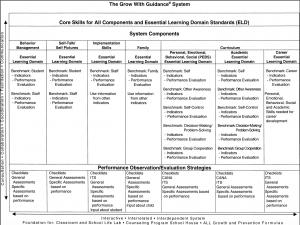
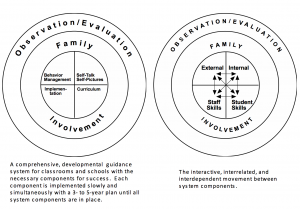
Overview of a Guidance System
- Behavior Management – Extrinsic – what we say and do
- Self-Talk & Self-Pictures – Intrinsic – what we say and believe with what we think and feel
- Curriculum – Student Skills
- Implementation – Staff Skills
- Family Involvement – Family Skills
- Observation/Evaluation
System Components Implemented
- Congruent
- Systemic – identify all components of the System or whole and understand the relationship between components
- Slowly and simultaneously
- 3-5 year process
- The Whole is larger than the sum of the parts
Classroom Group Guidance System Checklist
-
- Positive Behavior Plan
- Share Benchmarks, Standards, and Indicators
- Self Concept Series/Weave as it relates to Behavior
- Five Star Class Meetings
- Class Responsibilities and Guidelines
- Problem Solving – “Help” vs “Hurt”
- Effective Behavior Interactions
- Problem Ownership
- Cooperative Strategies
- Contracts
- Peer Group Work
- The Five C’s for Maintaining Conflict
- Performance Observation/Evaluation
- Increase Component Implementation Annually
- Self-Talk/Self-Pictures Plan
- Share Benchmarks, Standards, and Indicators
- Self Concept Series/Weave as it relates to Self-Talk/Self-Pictures
- Activity Process General Self-Talk
- Activity Process Specific Self-Talk
- Activity Process General Self-Pictures
- Activity Process Specific Self-Pictures
- Incorporate Relaxation
- Performance Observation/Evaluation
- Increase Component Implementation Annually
- Curriculum Plan
- Share Benchmarks, Standards, and Indicators
- Self Concept Series/Weave as it relates to Student Skills
- Begin Core Activities
- CANA (Children’s Affect Needs Assessment) Administered
- ITS (Invitational Teaching Survey) Administered
- Florida Key Administered
- CANA Pre Report
- ITS Pre Report
- Florida Key Pre Report
- Selective Activities
- Format Implemented for all Activities
- Performance Observation/Evaluation
- Post CANA, Post ITS, and Post Florida Key Tests Administered
- CANA, ITS, and Florida Key Post Reports
- Report summary written including all year-end performance Observation/Evaluation information
- Increase Component Implementation Annually
- Staff Improvement Skills
- Share Benchmarks, Standards, and Indicators
- Self Concept Series/Weave as it relates to Staff
- Overview of the System
- Overview of Behavior Management Component
- Overview of Self-Talk/Self-Pictures Component
- Overview of Staff Implementation Skills
- Overview of Curriculum Component
- Conduct Staff Needs Assessment
- Prioritize Staff Skills
- Encouragement Strategies
- Prioritize Group Techniques
- Prioritize Other Needs Based on the ITS and Needs Assessment
- Performance Observation/Evaluation
- Increase Component Implementation Annually
- Family Involvement
- Share Benchmarks, Standards, and Indicators
- Self Concept Series/Weave as it relates to Family
- Overview of the System
- Overview of Behavior Management Component
- Overview of Self-Talk/Self-Pictures Component
- Overview of Staff Implementation Skills
- Overview of Student Curriculum Component
- Conduct Family Needs Assessment
- Prioritize Skills from Behavior Management Component
- Prioritize Skills from Self-Talk/Self-Pictures Management Component
- Prioritize Skills from Staff Implementation Skills
- Prioritize Skills from Curricular Core and Other Skills
- Performance Observation/Evaluation
- Increase Component Implementation Annually
- Positive Behavior Plan
It is recommended that all system information be included for families when possible.
- Developed a 3-to-5 year plan in the components for simultaneous, slow implementation
- Behavior Management
- Self-Talk/Self-Pictures
- Curriculum
- Implementation Skills
- Family Involvement
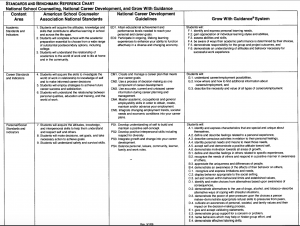
Traditional Classroom
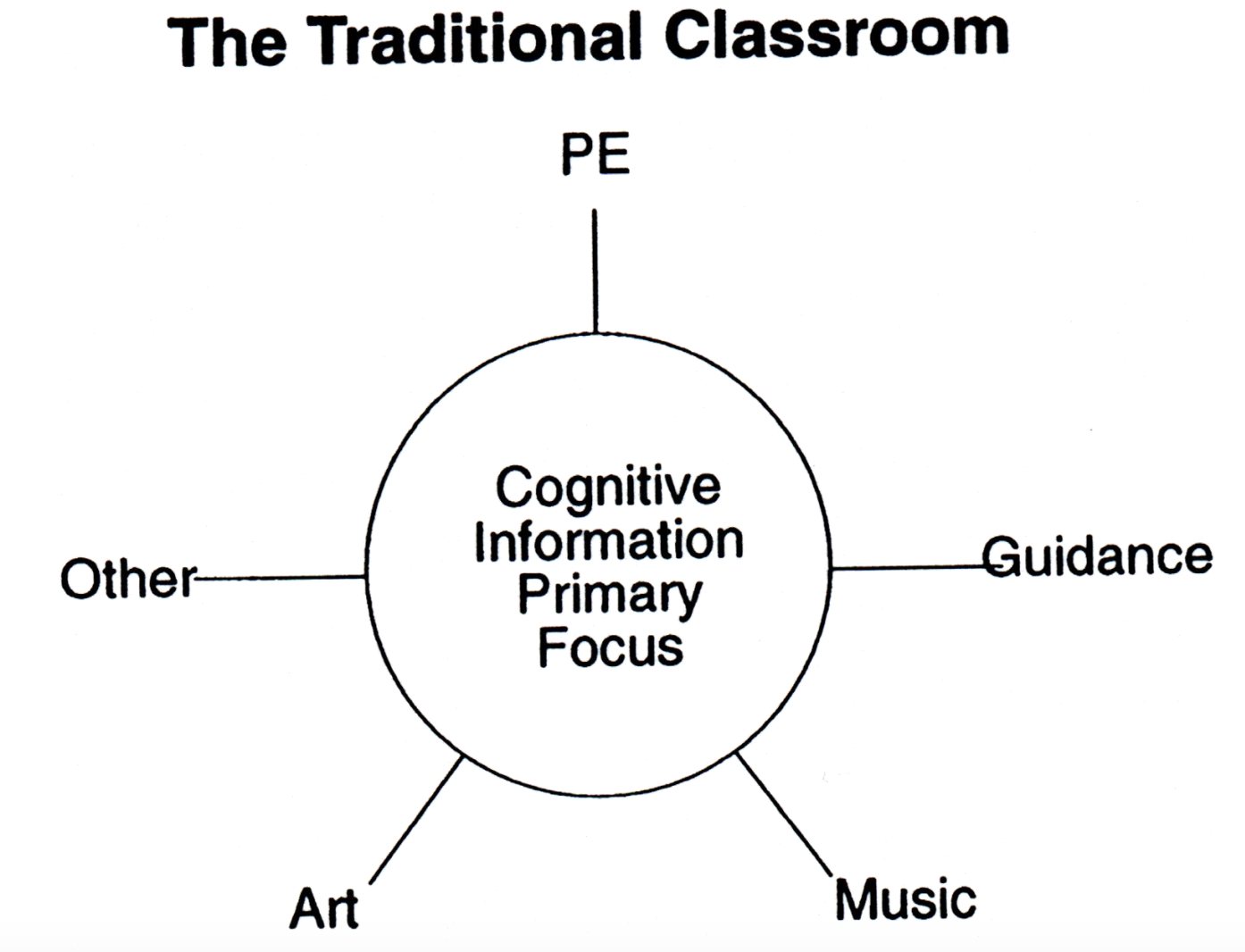
Real Classroom
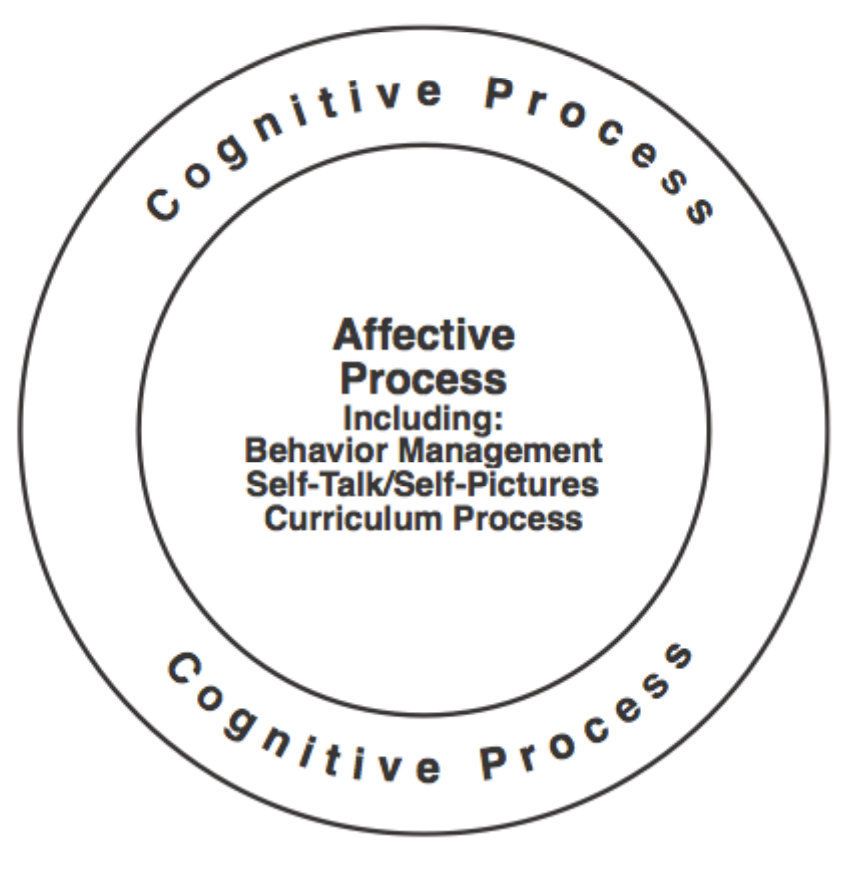
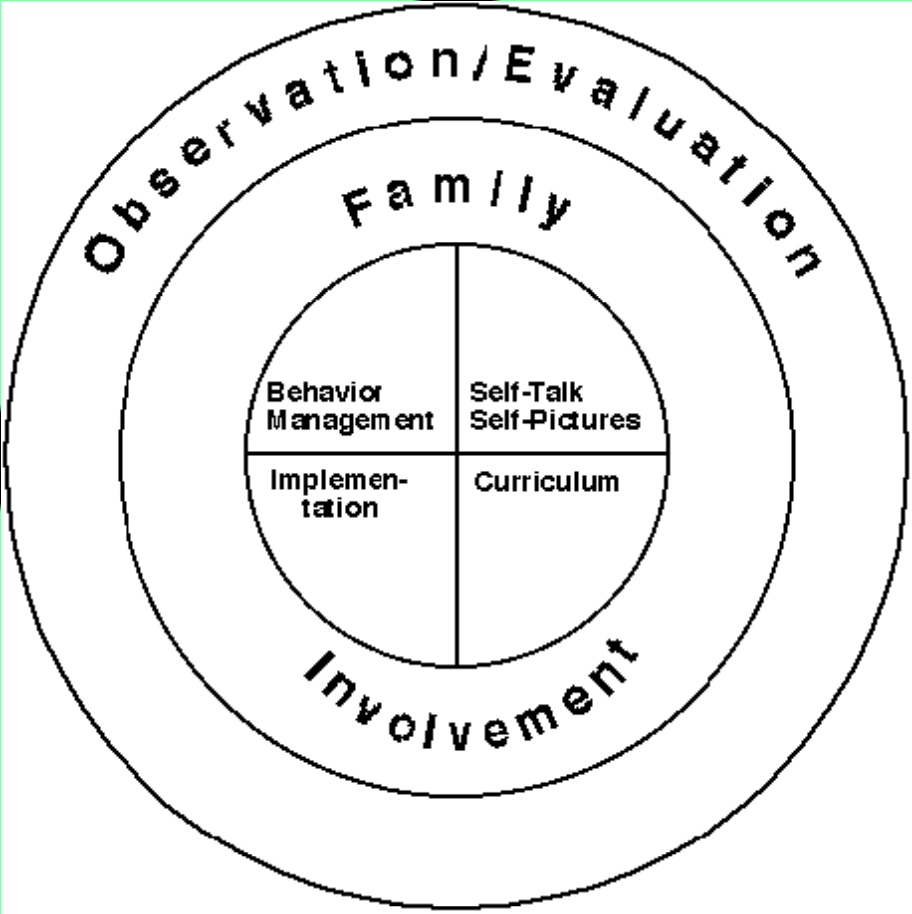
Life Lab
A way of defining the classroom as a simulation in which students, pre-K-12 and beyond, learn, experience, and apply the essential skills needed for life; the comprehensive developmental guidance system creates a life lab in every classroom through which students develop a conscious and intentional frame of reference that can be applied throughout life.
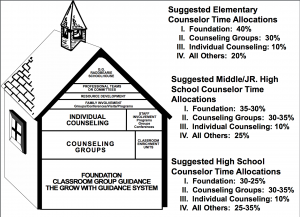
Suggested Elementary Counselor Time Allocations
- Foundation: 40%
- Counseling Groups: 30%
- Individual Counseling: 10%
- All Others: 20%
Suggested Middle/JR. High School Counselor Time Allocations
- Foundation: 35-30%
- Counseling Groups: 30-35%
- Individual Counseling: 10%
- All Others: 25%
Suggested High School Counselor Time Allocations
- Foundation: 30-25%
- Counseling Groups: 30-35%
- Individual Counseling: 10%
- All Others: 25-35%

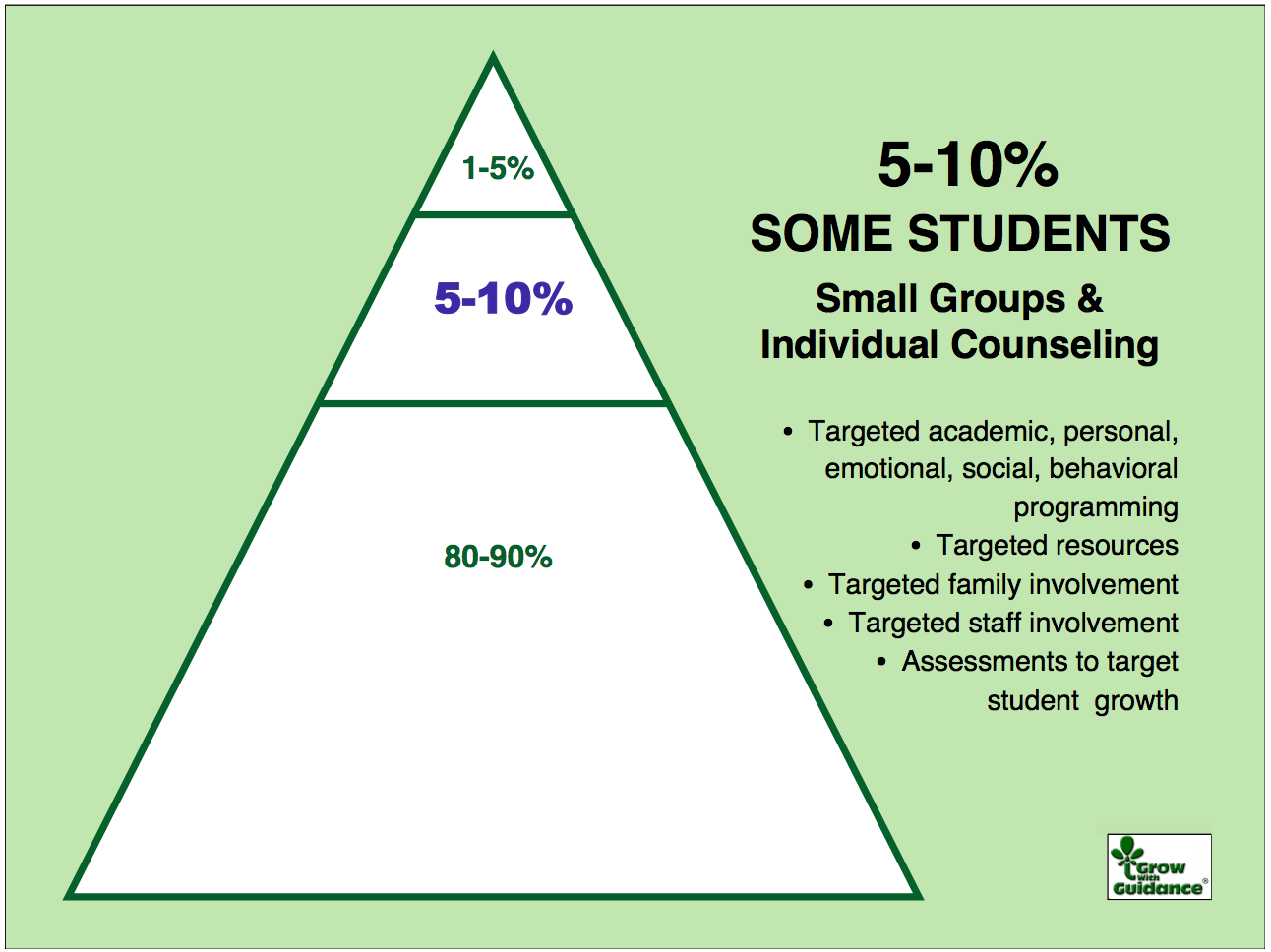
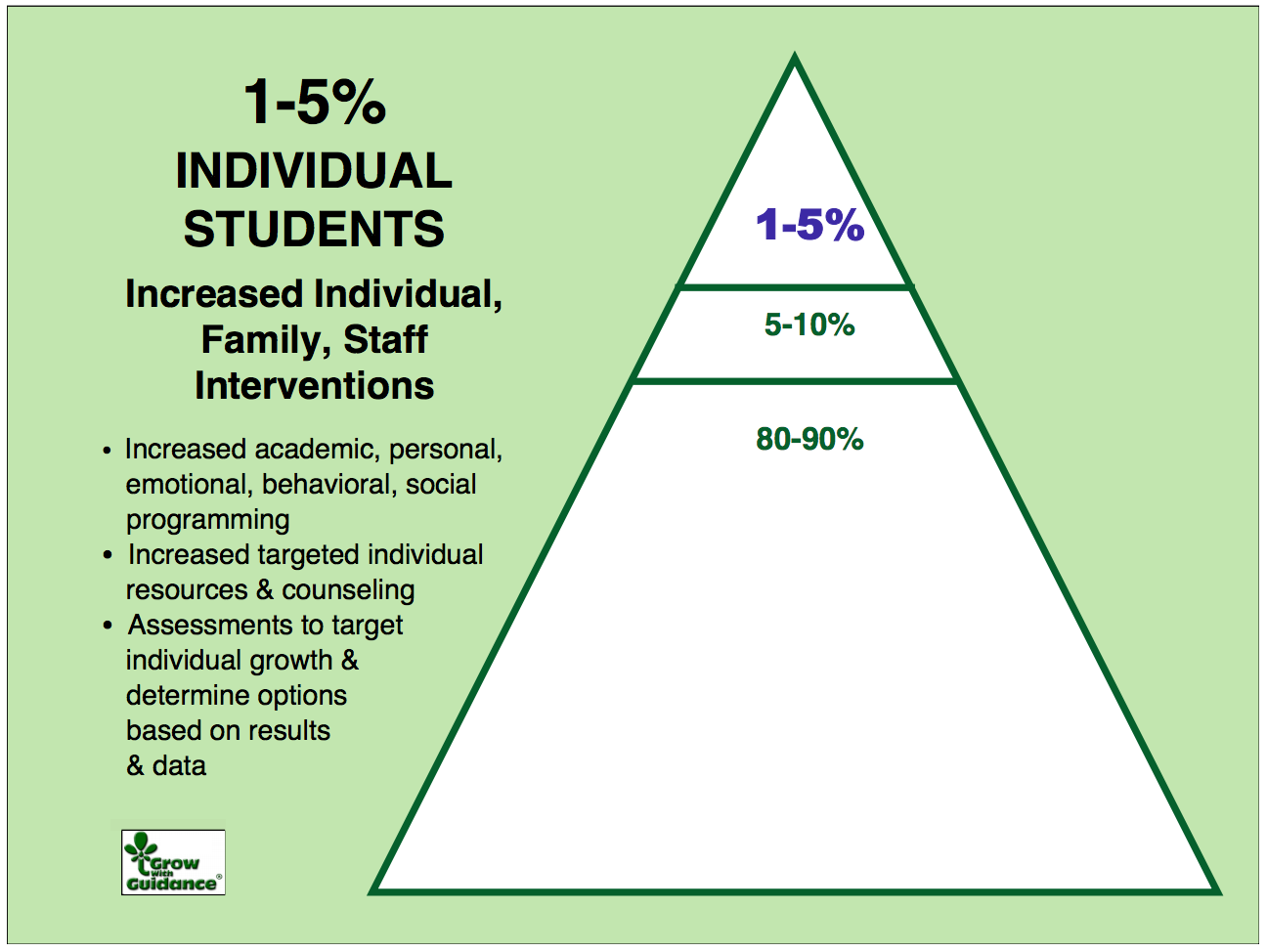
Personal, social, emotional and behavioral skills are the only constant in every situation. The level of development of those skills determines if one will respond or react over time. — Tommie R. Radd, PhD
Remember:
The impact of Social Emotional Learning Programs is documented by recent research to increase academic
achievement test scores by up to 11 percentile points. The Systems approach demonstrates ways to create an inviting school climate while effectively meeting the learning needs for all students with an RTI process that addresses the needs of the whole child.
Counseling System and Program?
Joel A. Barker, Futurist
Keynote address – Battelle for Kids Value-Added Conference, October 2006
- School is a place that is a “life preparation center.”
- Real live collaboration is 50% of all work in the real world.
Invitational Education Formula
Students can develop their spirit, purpose and potential when . . .
GWG Assessments Self-Concept Series Resources
Invitational Teaching Survey (ITS)
A 43-question diagnostic class climate assessment, taken by students, which gives student input about their classroom experiences and whether they have a feeling of being “invited”; a diagnostic tool to involve students and get their input on ways to improve climate and school relationships; one indicator of ways to support staff growth experiences and plans; one way to observe and evaluate change at the end of a school year through pre-post assessment; the school climate assessment included in The Grow With Guidance® System.
Children’s Affect Needs Assessment (CANA)
A 42-question diagnostic curriculum assessment taken by students that provides student input into their classroom guidance curriculum activity selection; a diagnostic tool to involve students and create a sense of student ownership for guidance skill implementation and change (Note: ownership occurs when students “own” a problem and admit, recognize, and acknowledge personal needs and challenges that support assuming responsibility and commitment for change); assessment questions asked in the five essential learning strands of the curriculum of The Grow With Guidance® System; one way to observe and evaluate change at the end of the school year through pre-post assessment; the student curriculum assessment included in The Grow With Guidance® System.
The Florida Key
Many in education, psychology, sociology, and related fields have recognized the significant relationship between self-concept and school achievement. On the basis of available research, it now appears that students who doubt their ability to learn in school carry with them a tremendous educational handicap. The purpose of The Florida Key is to provide teachers, counselors, and related professionals with a relatively simple instrument designed to measure both inferred and professed student self-concept-as-learner. It provides teachers and related professionals insight into students’ perceptions of themselves as learners. The Florida Key identifies and measures selected student behaviors that are believed by classroom teachers to correlate with positive realistic student self-concepts in the area of school success.
The Self-Concept Series is taught to all students.
NOTE: See Pod Cast at www. allsucceed.com
References
Radd, T. R. (2014). Teaching and Counseling for Today’s World: Pre-K-12 & Beyond Second Edition. Columbus, Ohio: Grow With Guidance. ISBN: 978-1-878317-58-2
Radd, T. R. (2014). Teaching and Counseling for Today’s World: Pre-K-12 & Beyond Second Edition, e-book. Columbus, Ohio: Grow With Guidance. ISBN: 978-1-878317-61-2
Radd, T. R. (2007). The Grow With Guidance System Manual Third Edition. Omaha, Nebraska: Grow With Guidance. ISBN: 978-1-878317-53-7 (1-878317-53-9).
Radd, T. R. (2014). The Grow With Guidance System Manual Third Edition, e-book. Columbus, Ohio: Grow With Guidance. ISBN: 978-1-878317-59-9
Radd, T. R. (2007). The Grow With Guidance Primary Level Third Edition. Omaha, Nebraska: Grow With Guidance. ISBN: 978-1-878317-54-4 (1-878317-54-7).
Radd, T. R. (2014). The Grow With Guidance Primary Level Third Edition, e-book. Columbus, Ohio: Grow With Guidance. ISBN: 978-1-878317-60-5
Radd, T. R. (2007). The Grow With Guidance Intermediate Level Third Edition. Omaha, Nebraska: Grow With Guidance. ISBN: 978-1-878317-55-1 (1-878317-55-5).
Radd, T. R. (2014). The Grow With Guidance System Intermediate Level Third Edition, e-book. Columbus, Ohio: Grow With Guidance. ISBN: 978-1-878317- 62-8
Radd, T. R. (2007). The Grow With Guidance Middle School Level Third Edition. Omaha, Nebraska: Grow With Guidance. ISBN: 978-1-878317-56-8 (1-878317-56-3).
Radd, T. R. (2014). The Grow With Guidance Middle School Level Third Edition, e-book. Columbus, Ohio: Grow With Guidance. ISBN: 978-1-878317-63-6
Radd, T. R. (2007). The Grow With Guidance High School Level Third Edition. Omaha, Nebraska: Grow With Guidance. ISBN: 978-1-878317-57-5 (1-878317-57-1)
Radd, T. R. (2014). The Grow With Guidance High School Level Third Edition, e-book. Columbus, Ohio: Grow With Guidance. ISBN: 978-1-878317-64-4 References
Radd, T. R. (2006). Classroom Activities for Teachers, Counselors, and Other Helping Professionals Pre-K–12 & Beyond Vol. I. Omaha, Nebraska: Grow With Guidance. ISBN: 1-878317-45-8
Radd, T. R. (2014). Classroom Activities for Teachers, Counselors, and Other Helping Professionals: Pre-K-12 & Beyond Vol I. Second Edition, e-book. Columbus, Ohio: Grow With Guidance. ISBN: 1-878317-65-2
Radd, T. R. (2006). Classroom Activiites for Teachers, Counselors, and Other Helping Professionals Pre-K–12 & Beyond Vol. II Omaha, Nebraska: Grow With Guidance. ISBN: 1-878317-46-6
Radd, T. R. (2014). Classroom Activities for Teachers, Counselors, and Other Helping Professionals: Pre-K-12 & Beyond Vol II Second Edition, e-book. Columbus, Ohio: Grow With Guidance. ISBN: 1-878317-65-
Radd, T. R. (2014). The Grow With Guidance System Music: G. G. Raddbearie Sings, e-book. Columbus, Ohio: Grow With Guidance. ISBN: 978-1-878317-68-7
Radd, T. R. (2007). The Grow With Guidance® System Music: G.G. Raddbearie Sings. Omaha, Nebraska: Grow With Guidance. isbn: 978-1-878317-47-6 (1-878317-47-4).
Radd, T. R. (2014). The Grow With Guidance System Fun Game Second Edition, e-book. Columbus, Ohio: Grow With Guidance. ISBN: 978-1-878317-67-9
Radd, T. R. (2007). The Grow With Guidance® System F.U.N. Game, Second Edition. Omaha, Nebraska: Grow With Guidance. ISBN: 978-1-878317-49-0 (1-878317-49-0)
Radd, T. R. (2006). The History, Development, and Research of the Educational Systems Model: The Grow With Guidance® System. Omaha, Nebraska: Grow With Guidance. isbn: 978-1-878317- 52-0 (1-878317-52-0).
A complete Research Report is available here.